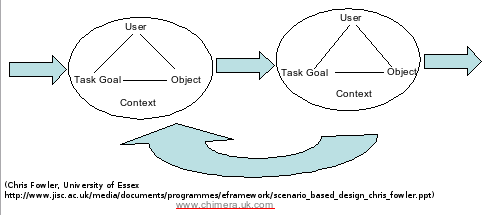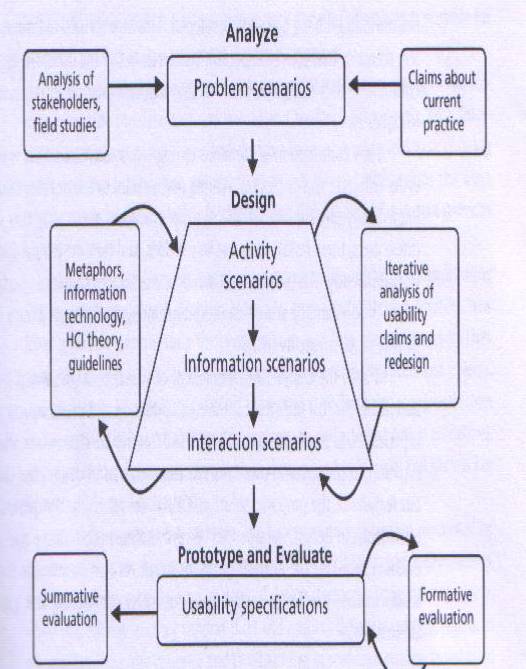Scenario-based usability engineering: Difference between revisions
m (using an external editor) |
m (using an external editor) |
||
| Line 7: | Line 7: | ||
An example use case in educational technology is the [[e-framework]] | An example use case in educational technology is the [[e-framework]] | ||
for which Chris Fowler made a [http://www.jisc.ac.uk/media/documents/programmes/eframework/scenario_based_design_chris_fowler.ppt presentation]. | for which Chris Fowler made a [http://www.jisc.ac.uk/media/documents/programmes/eframework/scenario_based_design_chris_fowler.ppt presentation]. | ||
This methodology also would be quite useful to engineer [[IMS learning design]]s. | |||
Scenario-based design elaborates a traditional theme in human | Scenario-based design elaborates a traditional theme in human | ||
| Line 16: | Line 17: | ||
Scenario-based design takes literally the adage that a tool is what | Scenario-based design takes literally the adage that a tool is what | ||
people can do with it - the consequences it has for them and for their activities that use it (Beth and Carroll, 2002). | people can do with it - the consequences it has for them and for their activities that use it (Beth and Carroll, 2002). | ||
According to Lewis and Rieman (1993:20), a {{quotation | scenario spells out what a user would have to | |||
do and what he or she would see step-by-step in performing a task using a | |||
given system. The key distinction between a scenario and a task is that a | |||
scenario is design-specific, in that it shows how a task would be performed | |||
if you adopt a particular design, while the task itself is design-independent: | |||
it's something the user wants to do regardless of what design is chosen. | |||
Developing the scenarios forced us to get specific about our design, and | |||
it forced us to consider how the various features of the system would work | |||
together to accomplish real work. }} | |||
== User needs analysis == | == User needs analysis == | ||
| Line 38: | Line 49: | ||
These narratives are constructed in an iterative process: | These narratives are constructed in an iterative process: | ||
[[image: user-needs-analysis-fowler.png|frame|none|Scenario-based User Needs Analysis. Origin: PPT slides Chris Fowler, University of Essex]] | |||
[[image: | |||
| Line 48: | Line 57: | ||
== Links == | == Links == | ||
* Fowler Chris, Scenario-based design, [http://www.jisc.ac.uk/media/documents/programmes/eframework/scenario_based_design_chris_fowler.ppt PPT slides], Chimera: Institute of Social and Technical Change, University of Essex. The initial version of this entry is based on these. | * [http://www.jisc.ac.uk/whatwedo/programmes/programme_eframework/eframework_modelling_workshop/synopsis_scenario.aspx Scenario-based design] page at JISC by Chris Fowler. Includes a pointer to Fowler Chris, Scenario-based design, [http://www.jisc.ac.uk/media/documents/programmes/eframework/scenario_based_design_chris_fowler.ppt PPT slides], Chimera: Institute of Social and Technical Change, University of Essex. The initial version of this entry is based on these. | ||
== References == | == References == | ||
| Line 57: | Line 66: | ||
* Hutt, A.T.H., Donnelly, N., Macaulay, L.A., Fowler, C.J.H., & Twigger, D. (1988) Describing a product opportunity : A method for understanding the users' environment. In D. Diaper & R. Winder (eds). People & Computers III. Cambridge: CUP. | * Hutt, A.T.H., Donnelly, N., Macaulay, L.A., Fowler, C.J.H., & Twigger, D. (1988) Describing a product opportunity : A method for understanding the users' environment. In D. Diaper & R. Winder (eds). People & Computers III. Cambridge: CUP. | ||
* Lewis, Clayton and John Rieman (1993) Task-Centered User Interface Design, A Practical Introduction, on-line book (shareware). [ftp://ftp.cs.colorado.edu/pub/cs/distribs/clewis/HCI-Design-Book/ PDF] | |||
* Rosson, M.B. and Carroll, J.M. (2002) Usability Engineering: Scenario-based Development of Human-Computer Interaction. London: Academic Press. | * Rosson, M.B. and Carroll, J.M. (2002) Usability Engineering: Scenario-based Development of Human-Computer Interaction. London: Academic Press. | ||
| Line 69: | Line 80: | ||
* Van Helvert, J. and Fowler, C. (2004) 'Scenarios for Innovation (SUNA)', in Alexander and N. Maiden (eds.) Scenarios and Use Cases Stories through the System Life-Cycle. London: Wiley. | * Van Helvert, J. and Fowler, C. (2004) 'Scenarios for Innovation (SUNA)', in Alexander and N. Maiden (eds.) Scenarios and Use Cases Stories through the System Life-Cycle. London: Wiley. | ||
[[Category: Design methodologies]] | [[Category: Design methodologies]] | ||
Revision as of 09:56, 28 April 2007
Definition
Scenario-based Usability Engineering (SUNA) is a design methodology.
An example use case in educational technology is the e-framework for which Chris Fowler made a presentation. This methodology also would be quite useful to engineer IMS learning designs.
Scenario-based design elaborates a traditional theme in human factors and ergonomics, namely, the principle that human charac- teristics and needs should be pivotal considerations in the design of tools and artifacts. In scenario-based design, descriptions of usage situations become more than just orienting examples and background data, they become first-class design objects. Scenario-based design takes literally the adage that a tool is what people can do with it - the consequences it has for them and for their activities that use it (Beth and Carroll, 2002).
According to Lewis and Rieman (1993:20), a “scenario spells out what a user would have to do and what he or she would see step-by-step in performing a task using a given system. The key distinction between a scenario and a task is that a scenario is design-specific, in that it shows how a task would be performed if you adopt a particular design, while the task itself is design-independent: it's something the user wants to do regardless of what design is chosen. Developing the scenarios forced us to get specific about our design, and it forced us to consider how the various features of the system would work together to accomplish real work.”
User needs analysis
The basic steps in needs analysis is to define a scenario:
- It must be a narrative (story)
- It should have a precise scope (like a real story) and a time-frame
- It should describe:
- actors
- activities (tasks). What they do.
- things (objects) used
In addition, there should be a purpose to the story for the design process, e.g.
- communication
- analysis/design
- decision-making
Therefore a scenario can describe:
- a current "as is" situation (what people do, see above). This will help problem analysis
- a future proposed situation and also "what happens if" situations. This will help to build representations, i.e. a paper-based prototye of a design.
These narratives are constructed in an iterative process:
Links
- Scenario-based design page at JISC by Chris Fowler. Includes a pointer to Fowler Chris, Scenario-based design, PPT slides, Chimera: Institute of Social and Technical Change, University of Essex. The initial version of this entry is based on these.
References
- Fowler, C.J.H, van Helvert, J; Gardner, M.G, and Scott, J.R. (in press). The use of scenarios in designing and delivering learning systems. In H. Beetham & R. Sharpe, Rethinking Pedagogy in a Digital Age: Designing and delivering e-learning. London: Routledge.
- Carroll, J.M (1995) Introduction: The Scenario Perspective on System Development. In J.M. Carroll (ed.) Scenario-Based Design: Envisioning work and Technology in System Development New York: Wiley
- Hutt, A.T.H., Donnelly, N., Macaulay, L.A., Fowler, C.J.H., & Twigger, D. (1988) Describing a product opportunity : A method for understanding the users' environment. In D. Diaper & R. Winder (eds). People & Computers III. Cambridge: CUP.
- Lewis, Clayton and John Rieman (1993) Task-Centered User Interface Design, A Practical Introduction, on-line book (shareware). PDF
- Rosson, M.B. and Carroll, J.M. (2002) Usability Engineering: Scenario-based Development of Human-Computer Interaction. London: Academic Press.
- Rosson, Mary Beth and John M. Carroll (2002), Scenario-based usability engineering, Proceedings of the conference on Designing interactive systems: processes, practices, methods, and techniques. http://doi.acm.org/10.1145/778712.778776 (PDF)
- Rosson, M. B., Carrol, J. M., and Rodi, C. 2004a. Case studies for teaching usability engineering. In Proceedings of the 35th SIGCSE Technical Symposium on Computer Science Education (Norfolk, VA, March 3-7, 2004). ACM Press, New York, 36-40.
- Rosson, M. B., Carrol, J. M., and Rodi, C. 2004b. Teaching computer scientists to make use. In Putting Scenarios Into Practice: The State of the Art in Scenarios and Use Cases. I. F. Alexander and N. Maiden (eds.). John Wiley, New York.
- Carroll, John M. and Mary Beth Rosson, A Case Library for Teaching Usability Engineering: Design Rationale, Development, and Classroom Experience, ACM Journal on Educational Resources in Computing, Vol. 5, No. 1, March 2005. PDF
- Van Helvert, J. and Fowler, C. (2004) 'Scenarios for Innovation (SUNA)', in Alexander and N. Maiden (eds.) Scenarios and Use Cases Stories through the System Life-Cycle. London: Wiley.

